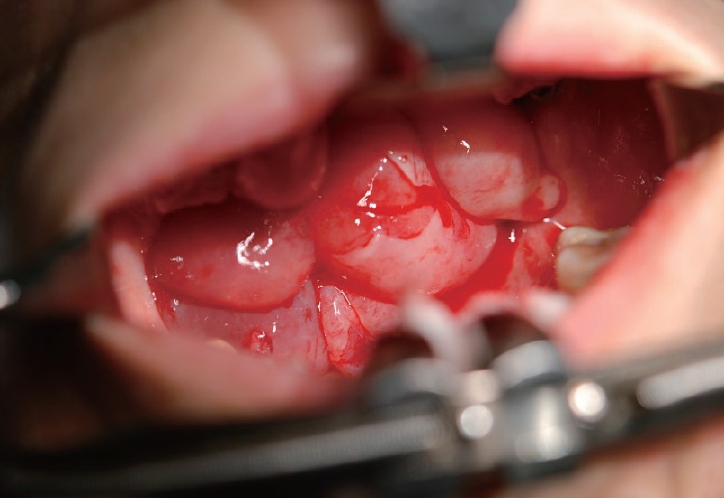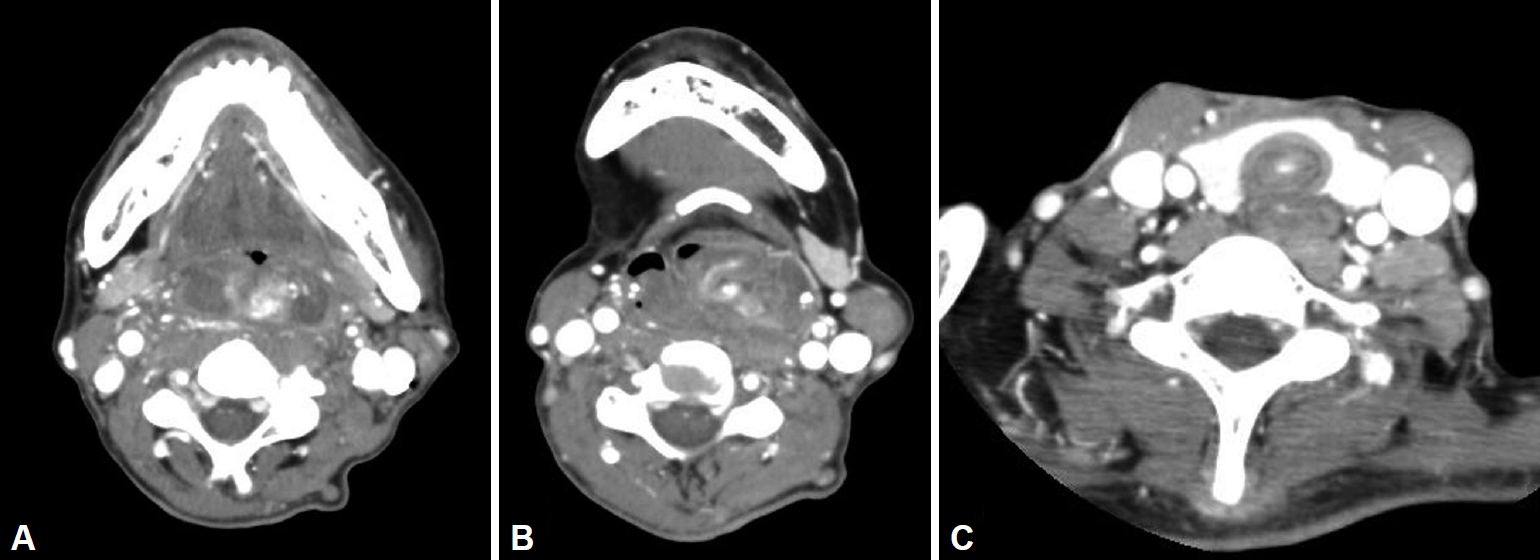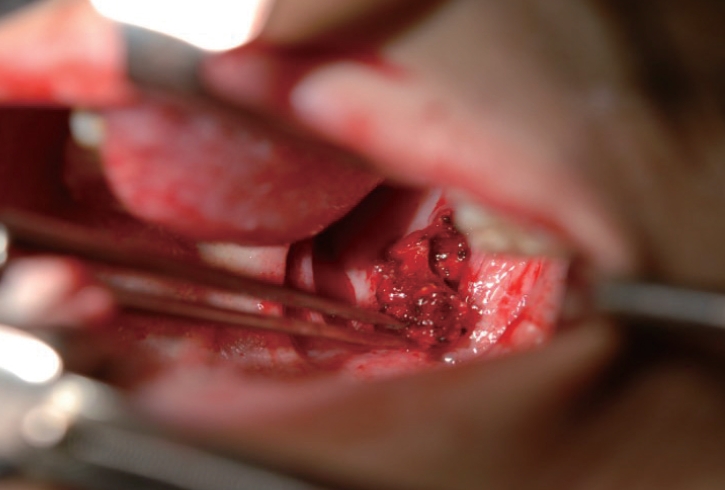AbstractGranuloma is an uncommon benign disease that develops in the process of wound healing. Pharyngeal or laryngeal granuloma can be associated with gastric reflux, mechanical injury or trauma including intubation, voice abuse, or foreign body. 50-year-old female was transferred to our institute with a huge mass occupying the upper aerodigestive tract causing dysphagia. The patient has been suffering from a brain hemorrhage for several months and was kept in bed due to the quadriplegia with stuporous mental status, and was tracheotomized. On examination, the whole oropharynx and hypopharynx was covered by a smooth-surfaced soft big diffuse granular mass, which extended down to the upper trachea through the larynx. The huge granuloma was successfully removed with surgery and was found to have a pedunculating stalk on the oropharyngeal posterior wall with a small mucosal defect, suggestive of the origin of the mass. The defect was closed primarily after the cauterization. The patient is now followed up regularly without any recurrence of the disease.
ņä£ļĪĀņ£ĪņĢäņóģņØĆ ņāüņ▓ś ņ╣śņ£Ā Ļ│╝ņĀĢņŚÉņä£ ņāØĻĖĖ ņłś ņ׳ļŖö ņ¢æņä▒ ļ│æļ│ĆņØ┤ļŗż. ņØĖļæÉļéś ĒøäļæÉņŚÉ ļ░£ņāØĒĢśļŖö ņ£ĪņĢäņóģņØĆ ĻĘĖ ļ░£ņāØ ĻĖ░ņĀäņŚÉ ļīĆĒĢ┤ņä£ ņĢäņ¦ü ņØ┤Ļ▓¼ņØ┤ ņ׳ņ£╝ļéś[1], ņ£äņé░ņØś ņŚŁļźś[2-4], ĻĖ░Ļ┤ĆņéĮĻ┤Ć ļō▒ņØś ĻĖ░Ļ│äņĀüņØĖ ņåÉņāü[5,6], ņ£äņé░ņØś ņŚŁļźśņÖĆ ĻĖ░Ļ│äņĀü ņåÉņāüņØś Ēś╝ĒĢ®[7], ņØīņä▒ ļé©ņÜ®[4], Ēś╣ņØĆ ņØ┤ļ¼╝ņ¦ł ļ░śņØæ[8]Ļ│╝ ņŚ░Ļ┤ĆļÉśĻĖ░ļÅä ĒĢ£ļŗż. ņłśņłĀņĀü ņĀłņĀ£Ļ░Ć Ēæ£ņżĆņĀüņØĖ ņ╣śļŻīļ▓Ģ[5]ņØ┤ņ¦Ćļ¦ī ļåÆņØĆ ņ×¼ļ░£ļźĀ[9,10]ņØä ļ│┤ņØ┤ĻĖ░ļÅä ĒĢ£ļŗż.
ļ│Ė ņŚ░ĻĄ¼ņ×ÉļŖö ĻĄ¼ņØĖļæÉ Ēøäļ▓ĮņŚÉņä£ ĻĖ░ņŗ£ĒĢśņŚ¼ ņØĖļæÉ ņĀäņ▓┤ļź╝ ņ╣©ļ▓öĒĢśĻ│Ā ĒøäļæÉ ļ░Å ĻĖ░Ļ┤ĆĻ╣īņ¦Ć ņŚ░ņןļÉśņ¢┤ ļé┤ļĀżņÖĆ ņŚ░ĒĢśĻ│żļ×ĆņØä ņ┤łļלĒ¢łļŹś Ļ▒░ļīĆ ņ£ĪņĢäņóģ ņ”ØļĪĆļź╝ ļ│┤Ļ│ĀĒĢśļ®┤ņä£ ĻĘĖ ņøÉņØĖņŚÉ ļīĆĒĢ£ Ļ│Āņ░░ņØä ĒĢśĻ│Āņ×É ĒĢ£ļŗż.
ņ”ØļĪĆ50ņäĖ ņŚ¼ņ×ÉĻ░Ć ņŚ░ĒĢśĻ│żļ×ĆņØä ĒśĖņåīĒĢśļ®░ ļ│æņøÉņŚÉ ņÖöļŗż. ĒÖśņ×ÉļŖö 9Ļ░£ņøö ņĀä ļćīņČ£ĒśłļĪ£ ņłśņłĀņØä ļ░øņĢśĻ│Ā ņé¼ņ¦Ćļ¦łļ╣äļĪ£ ņ╣©ņāü ņāØĒÖ£ņØä ĒĢśĻ│Ā ņ׳ņŚłļŗż. ņØśņŗØņØĆ Ēś╝ļ»ĖĒĢ£ ņāüĒā£ļĪ£ ņØśņé¼ņåīĒåĄņØ┤ ņ¢┤ļĀżņøĀņ£╝ļ®░, ĻĖ░Ļ┤ĆņĀłĻ░£ņłĀņØä ļ░øĻ│Ā ĒŖ£ļĖīĻ░Ć ņéĮņ×ģļÉśņ¢┤ ņ׳ņŚłļŗż. ņ£äņĪ░ļŻ©(gastrostomy)ļź╝ ĒåĄĒĢśņŚ¼ ņŻ╝ļÉ£ ņśüņ¢æ Ļ│ĄĻĖēņØä ĒĢśļ®┤ņä£ ĻĄ¼Ļ░Ģ ņŗØņØ┤ļź╝ ņĪ░ĻĖłņö® ļ│æĒ¢ēĒĢśļŹś ĒÖśņ×ÉļĪ£, ĻĄ¼Ļ░Ģ ņŗØņØ┤Ļ░Ć ņĀäĒśĆ ņĢł ļÉśņ¢┤ ļ│Ė ļ│æņøÉņ£╝ļĪ£ ņĀäņøÉļÉśņŚłļŹś Ļ▓āņØ┤ļŗż.
ņŗĀņ▓┤ Ļ▓Ćņé¼ņāü, ļ░▒ņāē Ēś╣ņØĆ ņśģņØĆ ļČäĒÖŹņāēņØś ļČĆļō£ļ¤ĮĻ│Ā ļ¦żļüłĒĢ£ Ēæ£ļ®┤ņØä Ļ░Ćņ¦ä ņŚ¼ļ¤¼ Ļ░£ņØś ņŚĮņØä Ļ░Ćņ¦ĆļŖö ļ»Ėļ¦īņä▒ ņ£ĪņĢäņä▒ ņóģļ¼╝ņØ┤ ĻĄ¼ņØĖļæÉ ņĀäņ▓┤ļź╝ ņĀÉņ£ĀĒĢśĻ│Ā ņ׳ņŚłļŗż(Fig. 1). ņØ┤ ļ│æļ│ĆņØĆ ņĀäņé░ĒÖöļŗ©ņĖĄņ┤¼ņśüņāü ĻĄ¼ņØĖļæÉļ┐Éļ¦ī ņĢäļŗłļØ╝ ĒĢśņØĖļæÉļź╝ ĒżĒĢ©ĒĢ£ ņØĖļæÉ ņĀäņ▓┤ļź╝ ņ░©ņ¦ĆĒĢśļ®┤ņä£, ĒøäļæÉļź╝ ĒåĄĻ│╝ĒĢśņŚ¼ ĻĖ░Ļ┤ĆĻ╣īņ¦Ć ņŚ░ņןļÉśņ¢┤ ļé┤ļĀżņÖĆ ņ׳ņŚłļŗż(Fig. 2). ņ£ĪņĢłņĀüņØĖ Ļ┤Ćņ░░ņāü ņĀĆļ¬ģĒĢśĻ▓ī ļČĆļō£ļ¤¼ņÜ┤ ņ¢æņä▒ ļ│æļ│Ćņ£╝ļĪ£ ņāØĻ░üņØ┤ ļÉśņŚłĻ│Ā, ļśÉĒĢ£ Ē¢źĒøä ņ▓ĀņĀĆĒĢ£ ņĀ£Ļ▒░ ņłśņłĀņØä Ļ│äĒÜŹĒĢśĻ│Ā ņ׳ņŚłĻĖ░ņŚÉ ņłĀ ņĀä ņĪ░ņ¦üĻ▓Ćņé¼ļŖö ņŗ£Ē¢ēĒĢśņ¦Ć ņĢŖņĢśļŗż.
ņĀäņŗĀļ¦łņĘ©ĒĢśņŚÉ ņłśņłĀņØä ņŗ£Ē¢ēĒĢśņśĆļŗż. ĒÖśņ×Éļź╝ ņĢÖņĢäņ£ä(supine position)ņŚÉņä£ Ļ░£ĻĄ¼ĻĖ░ļź╝ Ļ▒ĖĻ│Ā ĻĄ¼ņØĖļæÉļź╝ ļģĖņČ£ņŗ£ņ╝░ļŗż. ņóģļ¼╝ņØ┤ ĻĄ¼ņØĖļæÉņÖĆ ĒĢśņØĖļæÉ Ēøäļ▓ĮņØä ĻĘĀļō▒ĒĢśĻ▓ī ļ¬©ļæÉ ņ╣©ļ▓öĒ¢łņØä Ļ▓āņ£╝ļĪ£ ņśłņāüĒĢśņśĆņ£╝ļéś, ņśłņāüĻ│╝ ļŗ¼ļ”¼ ĒĢśņØĖļæÉņÖĆ ĒøäļæÉ ļ│æļ│ĆņØĆ ņŗżņĀ£ ņĀÉļ¦ēņØä ņ╣©ļ▓öĒĢśņ¦Ć ņĢŖĻ│Ā ĻĄ¼ņØĖļæÉ ņóģļ¼╝ņØ┤ ņĢäļלļĪ£ ļé┤ļĀżņśżļŖö ĒśĢĒā£(pedunculating)ņśĆļŗż.
Ļ▓Ėņ×Éļź╝ ņØ┤ņÜ®ĒĢśņŚ¼ ĒøäļæÉ ļ░Å ĻĖ░Ļ┤ĆĻ│╝ ĒĢśņØĖļæÉļĪ£ ļé┤ļĀżņś© ņóģļ¼╝ņØä ļ¬©ļæÉ ņĀ£Ļ▒░ĒĢśĻ│Ā ĻĄ¼ņØĖļæÉ ņóģļ¼╝ņØś ļīĆļČĆļČäņØä ņĀ£Ļ▒░ĒĢśņśĆļŗż(Fig. 3). ĻĘĖļ¤░ļŹ░ ĻĄ¼ņØĖļæÉ ļČĆņ£äņŚÉņä£ļŖö ļīĆļČĆļČäņØś ņ£ĪņĢäņóģņØ┤ ņĀ£Ļ▒░ļÉ£ ĒøäņŚÉ ņØ╝ļČĆ ņĪ░ĻĘĖļ¦łĒĢ£ ņ£ĪņĢäņóģņØ┤ Ēøäļ▓ĮņŚÉ ļČÖņ¢┤ ņ׳ņ¢┤, ņØ┤ ļČĆņ£äĻ░Ć ņ£ĪņĢäņóģņØś ĻĖ░ņŗ£ ļČĆņ£äņ×äņØä ņČöņĀĢņ╝Ć ĒĢśņśĆļŗż. ĻĄ¼ņØĖļæÉ Ēøäļ▓ĮņØś ļé©ņØĆ ļČĆļō£ļ¤¼ņÜ┤ ņ£ĪņĢäņóģņØä ļ¬©ļæÉ ņĀ£Ļ▒░ĒĢśĻ│Ā Ļ┤Ćņ░░ĒĢ£ Ļ▓░Ļ│╝, ņĢĮ 2 cm ņĀĢļÅäņØś ņäĖļĪ£ ļ░®Ē¢źņØś ņĀÉļ¦ē Ļ▓░ņåÉ ļČĆņ£äĻ░Ć ņ׳ņŚłņ£╝ļ®░ ļö▒ļö▒ĒĢśĻ│Ā ņŻ╝ļ│Ć ņĪ░ņ¦üņ£╝ļĪ£ ņ£Āņ░®ļÉ£ ņä¼ņ£Ā ņĪ░ņ¦üņ£╝ļĪ£ ļ│ĆĒÖöļÉśņ¢┤ ņ׳ņŚłĻ│Ā, ņØ┤ ļČĆņ£äĻ░Ć ļ░öļĪ£ ņ£ĪņĢäņóģņØś ĻĖ░ņŗ£ļČĆņ×äņØä ņĢī ņłś ņ׳ņŚłļŗż(Fig. 4).
Ļ▓░ņåÉ ļČĆņ£ä ļ│æļ│ĆņØä ņĀäĻĖ░ņåīņ×æņłĀļĪ£ ņ▓ŁņåīĒĢśĻ│Ā ņ¢æņ¬Į ņĀÉļ¦ēņØä ļŗ╣Ļ▓© ņØ╝ņ░© ļ┤ēĒĢ®ņØä ņŗ£Ē¢ēĒĢśņśĆļŗż(Fig. 5). ņĀłņĀ£ļÉ£ ņóģļ¼╝ņØĆ ņĪ░ņ¦üĻ▓Ćņé¼ņāü ļ»ĖņäĖ ĒśłĻ┤ĆĻ│╝ ĒĢ©Ļ╗ś ņä¼ņ£ĀņĢäņäĖĒżņØś ņ”ØņŗØĻ│╝ ņŚ╝ņ”Øņä▒ ņäĖĒżņØś ņ╣©ņ£żņØä ļ│┤ņŚ¼ ņ£ĪņĢäņĪ░ņ¦üņ×äņØ┤ ĒÖĢņØĖļÉśņŚłļŗż(Fig. 6).
ĒÖśņ×ÉļŖö Ēć┤ņøÉ Ēøä 3ņŻ╝ ļ¦īņŚÉ ļ│æņøÉņŚÉ ļé┤ņøÉĒĢśņśĆņ£╝ļ®░, ņØ┤ ļĢī ņ£äņĪ░ļŻ©ļź╝ ĒåĄĒĢ£ ņśüņ¢æ Ļ│ĄĻĖēņØä ĒĢśĻ│Ā ņ׳ņŚłņ¦Ćļ¦ī ĻĄ¼Ļ░Ģņ£╝ļĪ£ļÅä ņŚ░ņŗØņØś ņŗØņØ┤ļź╝ ĒĢśĻ│Ā ņ׳ņŚłņ£╝ļ®░ ņŚ░ĒĢś Ļ│żļ×ĆņØ┤ļéś ĒØĪņØĖņØĆ ĒśĖņåīĒĢśņ¦Ć ņĢŖņĢśļŗż. ĒāłĻ┤Ć(decannulation)ņØä ĻČīņ£ĀĒĢśņśĆņ£╝ļéś, ņÜöņ¢æļ│æņøÉ ņØśļŻīņ¦äĻ│╝ ļ│┤ĒśĖņ×ÉĻ░Ć Ē¢źĒøä ĒÖśņ×É ņāüĒā£ņØś ņĢģĒÖö ļō▒ņØä ņŚ╝ļĀżĒĢśņŚ¼ ņ£Āņ¦ĆĒĢśĻĖ░ļĪ£ ĒĢśņśĆļŗż. 3Ļ░£ņøö ĒøäņØś ļé┤ņŗ£Ļ▓Į ņé¼ņ¦äņāü ņóģļ¼╝ņØś ņ×¼ļ░£ ņŚåņØ┤ ĻĄ¼ņØĖļæÉ Ēøäļ▓ĮņØ┤ ĒÜīļ│ĄļÉśņŚłņØīņØä ĒÖĢņØĖĒĢśņśĆļŗż(Fig. 7).
Ļ│Āņ░░Shimazu ļō▒[11]ņØĆ 8ņŻ╝ ņŚ░ļĀ╣ņØś ņźÉņŚÉņä£ ņ£äņŗØļÅäņŚŁļźś ļ¬©ļŹĖņØä ļ¦īļōżņŚłļŗż. ņ”ē, ņ£äņØś ņ£Āļ¼Ė Ļ┤äņĢĮĻĘ╝(pyloric sphincter)ņØä ņÖĖļČĆņŚÉņä£ ļ¼ČĻ│Ā, ņĀäņ£ä(forestomach)ņÖĆ ņäĀ ļČĆņ£ä(glandular portion) ņé¼ņØ┤ņŚÉ ņ׳ļŖö ņØ┤Ē¢ē ļČĆņ£ä(transitional region)ļź╝ ņŗżļĪ£ ļ┤ēĒĢ®ĒĢśņŚ¼ ņ£äņé░ņØ┤ ņŗØļÅäļĪ£ ņŚŁļźśĒĢśĻ▓ī ļ¦īļōżņŚłļŗż. ĻĘĖļ¤░ļŹ░ ņØ┤ ļ¬©ļŹĖņŚÉņä£ ņ£äņé░ ņŚŁļźśņŚÉ ņØśĒĢ£ ĒøäļæÉ ņĀÉļ¦ēņØś ņŚ╝ņ”Ø ļ│ĆĒÖö(ņĀÉļ¦ēņØś ļ╣äĒøä, ĒśłĻ┤ĆņØś ņ”ØņŗØ ļ░Å ĒÖĢņן)ļŖö ņ׳ņŚłņ£╝ļéś 20ņŻ╝ ļÅÖņĢłņØś Ļ┤Ćņ░░ņŚÉļÅä ļČłĻĄ¼ĒĢśĻ│Ā ņ£ĪņĢäņĪ░ņ¦üņØĆ ļ░£ņāØĒĢśņ¦Ć ņĢŖņĢśļŗżĻ│Ā ĒĢśņśĆļŗż.
ņØ┤ļōżņØĆ ņØ┤ ļ¬©ļŹĖņØä ļ░öĒāĢņ£╝ļĪ£ ļæÉ ļ▓łņ¦Ė ņŚ░ĻĄ¼ļź╝ ņŗ£Ē¢ēĒĢśņśĆļŖöļŹ░[7], ņØ┤ļ▓łņŚÉļŖö ņźÉļź╝ ņ£äņŗØļÅäņŚŁļźśļź╝ ļ¦īļōĀ ĻĄ░Ļ│╝ ļīĆņĪ░ĻĄ░(ļ│ĄļČĆ ņżæņĢÖņĀłĻ░£ļ¦ī ņŗ£Ē¢ēĒĢ£ ĻĄ░), ļæÉ ĻĄ░ņ£╝ļĪ£ ļéśļłäĻ│Ā, ļ¬©ļōĀ ĻĄ░ņŚÉņä£ ĒöīļØ╝ņŖżĒŗ▒ ļ¦ēļīĆĻĖ░ļź╝ ĻĖ░Ļ┤Ć ņĢłņŚÉ ļäŻņØĆ Ēøä 3ņ┤łĻ░ä ņłśņ¦üņ£╝ļĪ£ ņäĖ ļ▓łņö® ņøĆņ¦üņŚ¼ņä£ ņä▒ļīĆ ņĀÉļ¦ēņŚÉ ņåÉņāüņØä ņŻ╝ņŚłļŗż. 2ņŻ╝Ļ░Ć ņ¦Ćļé£ Ēøä ļīĆņĪ░ĻĄ░ņŚÉņä£ļŖö ĒøäļæÉ ņĀÉļ¦ēņŚÉ ņ░░Ļ│╝ņāüĻ│╝ ņłśĒżļ¦ī Ļ┤Ćņ░░ļÉśņŚłņØä ļ┐É ņ£ĪņĢäņĪ░ņ¦üņØĆ ĒśĢņä▒ļÉśņ¦Ć ņĢŖņĢśņ£╝ļéś, ņ£äņŗØļÅäņŚŁļźśĻĄ░ņŚÉņä£ļŖö 60%ņØś ņźÉņŚÉņä£ ņ£ĪņĢäņĪ░ņ¦üņØ┤ Ļ┤Ćņ░░ļÉśņŚłĻ│Ā, ņØ┤Ļ▓āņØĆ ņé¼ļ×īņŚÉĻ▓īņä£ ļéśĒāĆļéśļŖö ņ£ĪņĢäņĪ░ņ¦üĻ│╝ ņĪ░ņ¦üĒĢÖņĀü ĒśĢĒā£Ļ░Ć ļ╣äņŖĘĒĢśņśĆļŗż.
ņØ┤ ļæÉ ņŗżĒŚś Ļ▓░Ļ│╝ļź╝ ĒåĀļīĆļĪ£ ņØ┤ļōżņØĆ ņ£äņé░ Ēś╣ņØĆ ĻĖ░Ļ│äņĀüņØĖ ņåÉņāü ļŗ©ļÅģņ£╝ļĪ£ļŖö ĒøäļæÉ ņĀÉļ¦ēņŚÉ ņ£ĪņĢäņĪ░ņ¦üņØä ĒśĢņä▒ņŗ£ĒéżĻĖ░ņŚÉ ņČ®ļČäĒĢśņ¦Ć ņĢŖņ£╝ļ®░, ņ£äņé░ ņŚŁļźśņÖĆ ĻĖ░Ļ│äņĀüņØĖ ņåÉņāüņØ┤ ļÅÖļ░śļÉśņŚłņØä ļĢī ņ£ĪņĢäņĪ░ņ¦üņØ┤ ĒśĢņä▒ļÉ£ļŗżĻ│Ā ļ│┤Ļ│ĀĒĢśņśĆļŗż.
ļ│Ė ņ”ØļĪĆņŚÉņä£ Ļ▒░ļīĆ ņ£ĪņĢäņĪ░ņ¦üņØ┤ ņØĖļæÉ Ēøäļ▓ĮņŚÉ ņāØĻĖ┤ ņØ┤ņ£Āļź╝ ņāØĻ░üĒĢ┤ ļ│┤Ļ│Āņ×É ĒĢ£ļŗż. Kim ļō▒[8]ņØ┤ ļ│┤Ļ│ĀĒĢ£ ļ░öņÖĆ Ļ░ÖņØ┤ Ļ▓ĮņČöņŚÉ Ļ│ĀņĀĢļÉ£ ĻĖłņåŹņŚÉ ļīĆĒĢ£ ņØ┤ļ¼╝ņ¦ł ļ░śņØæņŚÉ ņØśĒĢ£ Ļ▓āņØĆ ļ░░ņĀ£ĒĢĀ ņłś ņ׳ļŗż. ņØĖļæÉ Ēøäļ▓ĮņØ┤ ņ£ĪņĢäņĪ░ņ¦üņØś ĻĖ░ņŗ£ļČĆļØ╝ļŖö Ļ▓āņØä Ļ░ÉņĢłĒ¢łņØä ļĢī, ņ¢┤ļŖÉ ņł£Ļ░ä ņØ┤ ļČĆņ£ä ņĀÉļ¦ēņŚÉ ĻĖ░Ļ│äņĀüņØĖ ņåÉņāüņØ┤ ņ׳ņŚłņØä Ļ▓āņ£╝ļĪ£ ņČöņĀĢļÉ£ļŗż. ļćīņČ£ĒśłĻ│╝ ņØ┤ļź╝ ņ╣śļŻīĒĢśļŖö Ļ│╝ņĀĢņŚÉņä£ ĻĖ░Ļ┤ĆņéĮĻ┤ĆņØ┤ļéś ļŗżļźĖ ņóģļźśņØś ņŗ£ņłĀ ļÅäņżæņŚÉņä£ ņØĖļæÉ ņĀÉļ¦ēņØ┤ ņåÉņāüļÉśņŚłņØä Ļ▓āņØ┤ļŗż. ĻĘĖļ”¼Ļ│Ā ņןĻĖ░Ļ░ä ņ╣©ņāü ņāØĒÖ£Ļ│╝ ļ╣äņ£äņśüņ¢æ(nasogastric) ĒŖ£ļĖī ņéĮņ×ģņ£╝ļĪ£ ņØĖĒĢ£ ņ£äņé░ ņŚŁļźśĻ░Ć ņ׳ņŚłņØä Ļ▓āņ£╝ļĪ£ ņČöņĀĢĒĢĀ ņłś ņ׳ļŗż. ļö░ļØ╝ņä£ ņØĖļæÉ Ēøäļ▓ĮņØś ņĀÉļ¦ē ņåÉņāüĻ│╝ ņ£äņé░ ņŚŁļźś ļæÉ Ļ░Ćņ¦Ć ņØĖņ×ÉĻ░Ć ļÅÖļ░śļÉśņ¢┤ ņŚ░ĒĢśĻ│żļ×ĆņØä ņ┤łļלĒĢśļŖö Ļ▒░ļīĆĒĢ£ ņ£ĪņĢäņĪ░ņ¦üņØ┤ ļ░£ņāØļÉśņŚłņØä Ļ▓āņ£╝ļĪ£ ņé¼ļŻīļÉ£ļŗż.
ļ│Ė ņ”ØļĪĆņ▓śļ¤╝ ņØĖļæÉ Ēøäļ▓ĮņŚÉ ņāØĻĖ┤ Ļ▒░ļīĆ ņ£ĪņĢäņóģņØĆ ļŗżļźĖ ļ¼ĖĒŚīņŚÉ ļ│┤Ļ│ĀļÉśņ¦Ć ņĢŖņØĆ ļ¦żņÜ░ ļō£ļ¼Ė Ļ▓ĮņÜ░ļĪ£ ĒīīņĢģļÉ£ļŗż. ņØ┤ņŚÉ ļ░śĒĢ┤ ņä▒ļīĆļÅīĻĖ░ ņ£ĪņĢäņóģņØĆ ņä▒ņØĖ ļé©ņ×ÉņŚÉĻ▓īņä£ ĒØöĒ׳ ļ░£ņāØĒĢśļŖö ņ¦łĒÖśņ£╝ļĪ£ ņŻ╝ļĪ£ ņ£äņŗØļÅäņŚŁļźś, ņéĮĻ┤Ć ņåÉņāü, ĻĘĖļ”¼Ļ│Ā ņØīņä▒ ļé©ņÜ®ņŚÉ ņØśĒĢ┤ ņāØĻĖ┤ļŗż. ņŻ╝ļĪ£ ļ░£ņä▒ņןņĢĀļź╝ ĒżĒĢ©ĒĢśņŚ¼ ļŗżļźĖ ņ”Øņāü, ņ”ē Ē׳ņŖżĒģīļ”¼ņä▒ ņ”Øņāü(globus symptom), ņĢĀņä▒, ĻĖ░ņ╣©, ņŚ░ĒĢśĒåĄ, ņØĖĒøäĒåĄņØä ņłśĻ░£ņøöņŚÉņä£ ņłśļģäņŚÉ Ļ▒Ėņ│É ĒśĖņåīĒĢ£ļŗż[9]. ĻĖ░Ļ┤ĆņéĮĻ┤Ć ĒøäņŚÉ ļ░£ņāØĒĢśļŖö Ļ▓ĮņÜ░ņŚÉļŖö ņä▒ņØĖ ņŚ¼ņä▒ņŚÉņä£ ĒØöĒĢśļ®░, ņØ╝ļ░śņĀüņØĖ ņ£ĪņĢäņóģĻ│╝ ļŗ¼ļ”¼ ĒŖ╣ņ¦ĢņĀüņ£╝ļĪ£ ņ╣śļŻī Ēøä ņל ņ×¼ļ░£ĒĢśņ¦Ć ņĢŖļŖöļŗż[12]. Ļ░Éļ│äĒĢ┤ņĢ╝ ĒĢĀ ņ¦łĒÖśņ£╝ļĪ£ļŖö ĒÄĖĒÅēņäĖĒżņĢö, ĒśłĻ┤Ćņóģ, ņ╣┤Ēżņŗ£ņ£Īņóģ, Ēś╣ņØĆ ĒśłĻ┤Ćņ£Īņóģ Ļ░ÖņØĆ ĒśłĻ┤Ćņä▒ ņ¦łĒÖś, ĒĢŁņāüĻĘĀ, ņ¦äĻĘĀ, Ēś╣ņØĆ ņé¼ļź┤ņĮöņØ┤ļÅäņ”Ø(sarcoidosis) Ļ░ÖņØĆ Ļ░ÉņŚ╝Ļ│╝ ņŚ░Ļ┤ĆļÉ£ ņŚ╝ņ”Ø ļ░śņØæņŚÉ ņØśĒĢ£ Ļ▓ĮņÜ░ ļō▒ņØ┤ļŗż[13,14].
NOTESAuthorsŌĆÖ Contribution Conceptualization: Joon Kyoo Lee. Data curation: Jongmin Kim. Formal analysis: Bong-Jin Shin. Investigation: Jongmin Kim. Methodology: Bong-Jin Shin. Project administration: Joon Kyoo Lee. Resources: Eun Kyung Jung. Software: Bong-Jin Shin. Supervision: Joon Kyoo Lee. Validation: Bong-Jin Shin. Visualization: Eun Kyung Jung. WritingŌĆöoriginal draft: Eun Kyung Jung. WritingŌĆöreview & editing: Joon Kyoo Lee. Approval of final manuscript: all authors. Fig.┬Ā1.Preoperative photograph exposed oropharynx with mouth gag demonstrating whitish to light pinkish soft smooth-surfaced diffuse lobulated granular mass occupying the whole oropharynx. 
Fig.┬Ā2.Axial neck CT with enhancement demonstrates heterogeneously enhanced well-demarcated thin-walled elliptical lobulated mass occupying oropharyngeal posterior wall (A) and hypopharyngeal posterior wall (B), extending into the trachea just above tracheotomy stoma through the larynx (C). 
Fig.┬Ā4.Intraoperative photograph demonstrates about 2 cm sized longitudinal mucosal defect in the oropharyngeal posterior wall with hard, adhesive, and fibrotic bed, suggesting this region as the origin of the granuloma. 
Fig.┬Ā5.Introperative photographs demonstrate treated defect of the oropharyngeal posterior wall with electrocauterization (A) and closed primarily (B). 
REFERENCES1. Song Y, Shi L, Zhao Y, Zhao D, Shi M, Deng Z. Surgical removal followed by radiotherapy for refractory vocal process granuloma. J Voice 2012;26(5):666.e1-5.
2. Delahunty JE, Cherry J. Experimentally produced vocal cord granulomas. Laryngoscope 1968;78(11):1941-7.
3. Tauber S, Gross M, Issing WJ. Association of laryngopharyngeal symptoms with gastroesophageal reflux disease. Laryngoscope 2002;112(5):879-86.
4. Devaney KO, Rinaldo A, Ferlito A. Vocal process granuloma of the larynx-recognition, differential diagnosis and treatment. Oral Oncol 2005;41(7):666-9.
5. Lee DH, Yoon TM, Lee JK, Lim SC. Surgical treatment outcomes of vocal process granuloma after endotracheal intubation. J Craniofac Surg 2018;29(4):e387-9.
6. Martins RH, Dias NH, Santos DC, Fabro AT, Braz JR. Clinical, histological and electron microscopic aspects of vocal fold granulomas. Braz J Otorhinolaryngol 2009;75(1):116-22.
7. Shimazu R, Kuratomi Y, Aoki S, Inokuchi A. Laryngeal granuloma in experimental rats with gastroesophageal reflux disease and mechanically injured vocal cord mucosa. Ann Otol Rhinol Laryngol 2014;123(4):247-51.
8. Kim JH, Lee SK, Hong JH, Moon BJ, Lee JK. Retropharyngeal granulation: delayed complication of anterior cervical diskectomy and fusion in C2-3. World Neurosurg 2019;125:87-92.
9. Hoffman HT, Overholt E, Karnell M, McCulloch TM. Vocal process granuloma. Head Neck 2001;23(12):1061-74.
10. Mitchell G, Pearson CR, Henk JM, Rhys-Evans P. Excision and low-dose radiotherapy for refractory laryngeal granuloma. J Laryngol Otol 1998;112(5):491-3.
11. Shimazu R, Kusano K, Kuratomi Y, Inokuchi A. Histological changes of the pharynx and larynx in rats with chronic acid reflux esophagitis. Acta Otolaryngol 2009;129(8):886-92.
12. de Lima Pontes PA, De Biase NG, Gadelha EC. Clinical evolution of laryngeal granulomas: treatment and prognosis. Laryngoscope 1999;109(2 Pt 1):289-94.
|
|
|||||||||||||||||||||||||||||||||||||||